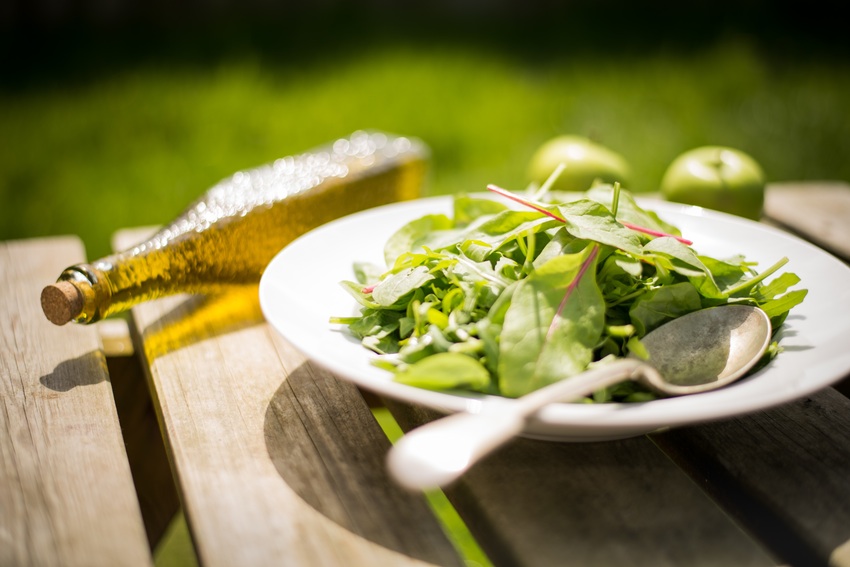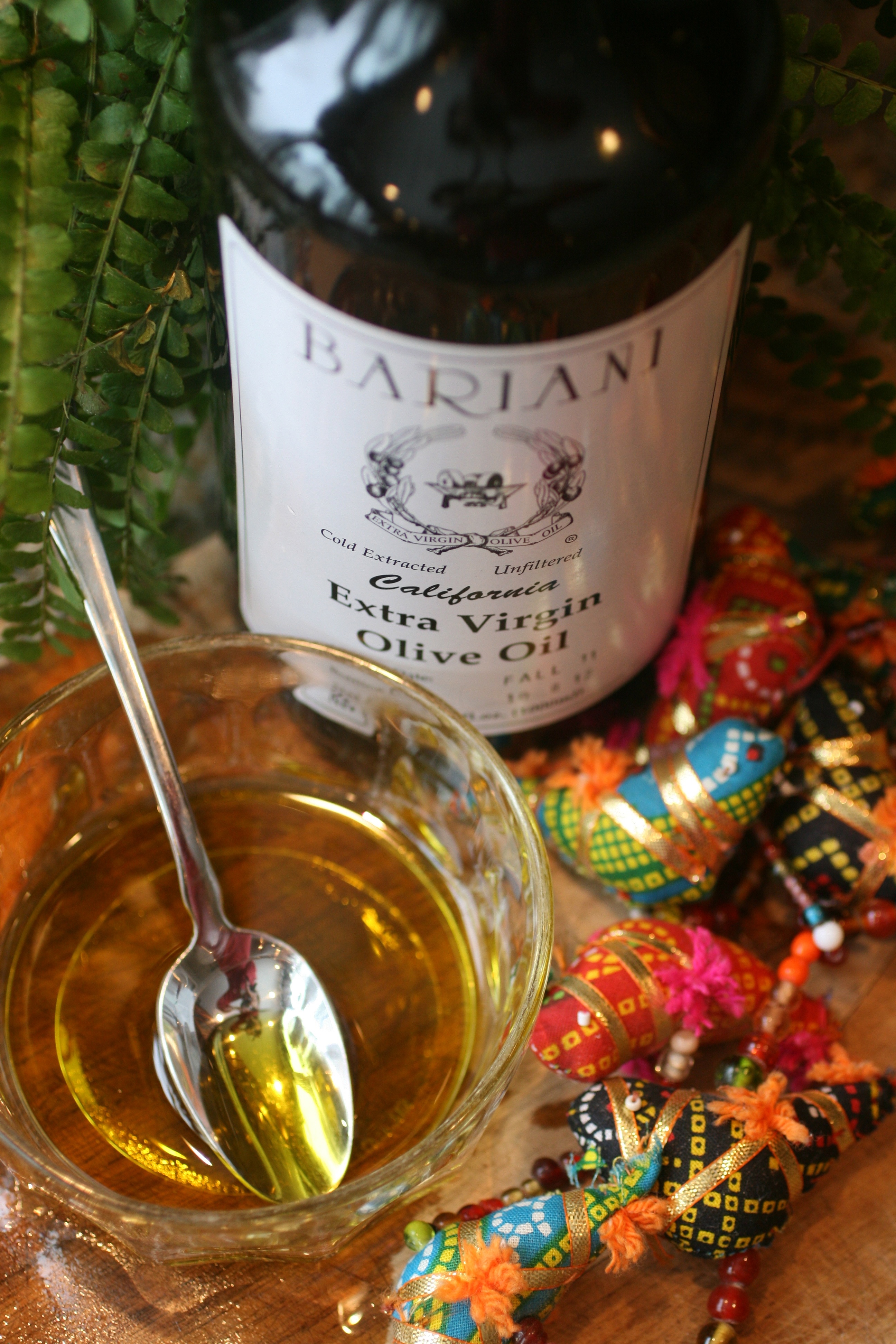With its highly palatable taste and wide availability, nearly everyone has heard about olive oil’s heart helping, cholesterol lowering, blood sugar regulating properties. Olive oil is popularly used in cooking: drizzled in the pan as a base for quick, hearty sautés or slathering over veggies for roasting. However what many people don’t realize is that this powerhouse plant oil is really best featured in dips and salad dressings where its 200 plus beneficial compounds and complex fatty acids can be enjoyed in the raw. In this article I'll share some of the key features to look for when selecting an olive oil, review tips for using it wisely in the kitchen, and share one of my favorite salad and homemade dressing recipes.
Health Benefits of Extra Virgin Olive Oil
Olive oil is unique for its high amount of very stable long-chain monounsaturated fats in the form of oleic acid (75%). Yet it is also of note that olive oil contains omega-3s (2%) and omega-6s (10%). While essential, these polyunsaturated fatty acids are readily denatured by heat and oxidize rapidly on storage. The valuable polyphenols in olive oil like reparative hydroxtyrosol (HT) and antioxidants such as beta-carotene and vitamin E are also sensitive to temperature. Thus for high-heat cooking, highly saturated fats like butter, lard, tallow, coconut oil, red palm oil and grass-fed ghee are more favorable everyday options. Reserve unfiltered olive oil for condiments and on occasions when its unique flavor best compliments the meal. Because really who can resist a robust homemade tomato sauce, pot roast or hearty beef stew without a drizzle of this delicious oil?
How to Select the Best Olive Oil
I’ve said it before and I will say it again, just because I think that this is one of the greatest real food hoaxes going: your olive oil is only as good as the olives that were used to create it, and the conditions under which it was created and kept. Unfortunately, most of the “extra virgin olive oil” you find in stores is not the real thing- even the organic kinds that come in fancy dark glass bottles. Because the markets in the United States and Italy are largely unregulated, manufacturers have found numerous cunning ways to adulterate the product including blending it with unstable vegetable oils like soybean oil or canola oil, or using rotting olives and then deodorizing the final product to neutralize the rank smell.
According to olive oil industry expert Tom Mueller, author of Extra Virginity: The Sublime and Scandalous World of Olive Oil, the very worst of the stuff goes into industrial food where it lurks unnoticed. “There’s a river of rotten oil going into food service,” he recently stated. “The big companies are selling things that are not even olive oil.” Just one more reason to steer clear of jarred sauces and dips - you just really don’t know what kinds of rancid infusions you are going to get.
It is also helpful to know key phrases to look out for on oil labels, and to be able to identify the aroma, fragrances and look of pure, unfiltered olive oil. I use Bariani Olive Oil, which I know is sourced and pressed directly at the organic family orchard. Hand-harvested, stone crushed, cold-pressed, decanted and unfiltered: this is the way olive oil should be.
When selecting an olive oil, there are some specific terms and criteria to keep in mind:
- Cloudy in appearance - shows oil is unfiltered and unadulterated by chemicals. These oils have instead been decanted- meaning that the debris from harvesting have been allowed to naturally fall from product with natural measure of time and gravity
- Golden-yellow in color - indicates that oil has been pressed from ripe olives at their prime
- Cold-pressed - ensures that the nutrients, fatty acid and lipase have not been destroyed in process. Olive oil naturally has a high smoking point, but is best if enjoyed in as raw a state as possible
- Extra virgin - meaning that oil is derived from first press of fruit only. It is the highest in quality and least processed method of delivery, offering a more balanced flavor.
- Dark-glass packed - protects oil from disagreeable oxidation during transportation from orchard to your home
Making Homemade Dressings With Olive Oil
Colorful collections of vegetables are meant to be gracefully displayed and adorned with healthy dressing. Using basic raw ingredients, homemade dressings offer a broad range of healthy fats, vitamin E, antioxidants and enzymes. Additionally they help us to absorb the fragile vital minerals and fat soluble vitamins in vegetables. Synergistically, oils and vegetables become super-charged when eaten together to promote cardiovascular, digestive, musculoskeletal and immune system health.

At Radiant Life, we try to incorporate a salad a day into our diets. The beauty of this process, is that each individual artfully prepares their salad masterpiece to suit particular tastes and nutritional needs. The recipe below is a simple, high protein option that is easily customized for your personal tastes and farmer's market finds.
Basic Salad with Olive Oil & Balsamic Dressing
By Kayla - Radiant Life
Basic Salad
Yields about 4 servings
3 cups fresh baby greens
1 cup arugula
1 avocado, medium and diced
1/4 cup sprouted organic pumpkin seeds
1 can Cole's wild mackerel in piri piri sauce
Balsamic Dressing
Makes about 3/4 cup
1 teaspon dijon-type mustard
2 tablespoons balsamic vinegar
1/2 cup extra virgin olive oil
1 tablespoon cold-pressed flax oil
To prepare dressing, dip fork into mustard jar and transfer about 1 teaspoon into small bowl. Add vinegar and mix. Add olive oil in thin stream until emulsified. Add flax oil and drizzle over tossed salad ingredients.
We love this combination because it offers fibrous vegetables full of vitamins and bioflavinoids as well as calcium and iron-rich protein sources. We add arugula for a bitter flavor to reset the palate and elicit the "bitter reflex" which helps stimulate appetite control and digestive function. In the dressing, the balsamic vinegar acts as a perfect pairing with olive oil for a woody, tangy taste. But remember- experiment! We are here to share ideas and tips, but your best learning technique is trying it yourself. Substitute walnut oil or pumpkin oil in the dressing. Use different nuts and seeds as protein sources, or add dried anchovies! Add your favorite in-season vegetables. The possibilities are endless! Enjoy!

